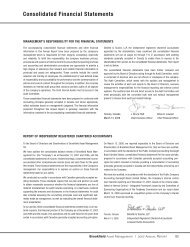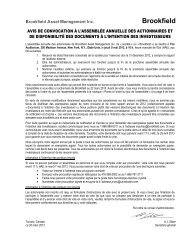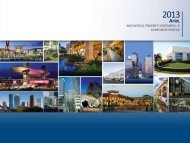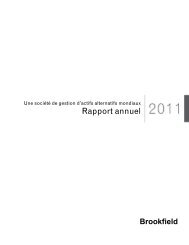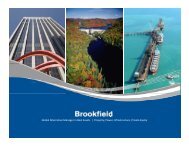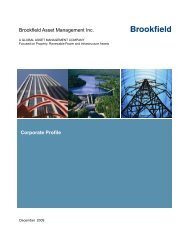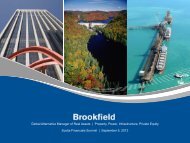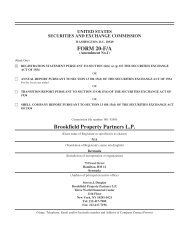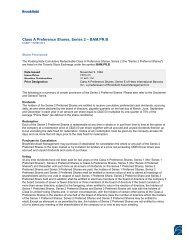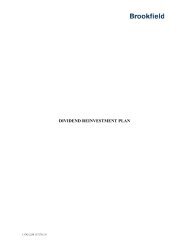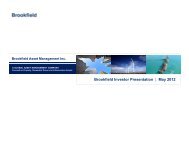Consolidated Financial Statements and Notes - Brookfield Asset ...
Consolidated Financial Statements and Notes - Brookfield Asset ...
Consolidated Financial Statements and Notes - Brookfield Asset ...
You also want an ePaper? Increase the reach of your titles
YUMPU automatically turns print PDFs into web optimized ePapers that Google loves.
(c) Property(i) Commercial propertiesCommercial properties held for investment are carried at cost less accumulated depreciation. For operating properties <strong>and</strong> propertiesheld for long-term investment, a write-down to estimated fair value is recognized when a property’s estimated undiscounted futurecash fl ow is less than its carried value. The projections of future cash fl ow take into account the specifi c business plan for eachproperty <strong>and</strong> management’s best estimate of the most probable set of economic conditions anticipated to prevail in the market.Depreciation on buildings is provided during the year ended December 31, 2005 on a straight-line basis over the useful lives of theproperties to a maximum of 60 years. Depreciation is determined with reference to the carried value, remaining estimated usefullife <strong>and</strong> residual value of each rental property. Tenant improvements <strong>and</strong> re-leasing costs are deferred <strong>and</strong> amortized over the livesof the leases to which they relate.Development properties consist of properties for which a major repositioning program is being conducted <strong>and</strong> properties whichare under construction. These properties are recorded at cost, including pre-development expenditures, unless an impairmentis identifi ed requiring a write-down to estimated fair value.EIC 140 requires that when a company acquires real estate in either an asset acquisition or business combination, a portion of thepurchase price should be allocated to the in-place leases to refl ect the intangible amounts of leasing costs, above or below marketleases <strong>and</strong> tenant relationship values, if any. These intangible costs are amortized over their respective lease terms.(ii) Residential propertiesHomes <strong>and</strong> other properties held for sale, which include properties subject to sale agreements, are recorded at the lower of cost<strong>and</strong> estimated fair value. Income received relating to homes <strong>and</strong> other properties held for sale is applied against the carried valueof these properties.Development l<strong>and</strong> <strong>and</strong> infrastructure is recorded at cost unless impairment is identifi ed requiring a write-down to estimated fairvalue. Costs are allocated to the saleable acreage of each project or subdivision in proportion to the anticipated revenue.(d) Power GenerationPower generating facilities are recorded at cost, less accumulated depreciation. The carried values of facilities are tested forimpairment when appropriate, based on an assessment of net recoverable amounts. A write-down to estimated fair value isrecognized if a facility’s estimated undiscounted future cash fl ow is less than its carried value. The projections of the future cashfl ow take into account the operating plan for each facility <strong>and</strong> management’s best estimate of the most probable set of economicconditions anticipated to prevail in the market. Depreciation on power generating facilities <strong>and</strong> equipment is provided at various rateson a straight-line basis over the estimated service lives of the assets, which are up to 60 years for hydroelectric generation assets.Power generating facilities under development are recorded at cost, including pre-development expenditures, unless impairmentis identifi ed requiring a write-down to estimated fair value.(e) Timber <strong>and</strong> InfrastructureTimber <strong>and</strong> infrastructure assets are carried at cost, less accumulated depletion <strong>and</strong> depreciation. A write-down to estimated fairvalue is recognized if the estimated undiscounted future cash fl ow from the timber <strong>and</strong> infrastructure assets is less than theircarried value. The projections of future cash fl ow take into account the operating plan for the timber <strong>and</strong> infrastructure assets<strong>and</strong> management’s best estimate of the most probable set of economic conditions anticipated to prevail in the market. Depletionof timber assets is determined based on the number of cubic metres of timber harvested annually at a fi xed rate. Depreciationon infrastructure transmission <strong>and</strong> distribution facilities is provided at various rates on a straight-line basis over the estimatedservice lives of the assets, which is up to 40 years.64<strong>Brookfield</strong> <strong>Asset</strong> Management | 2005 Annual Report



